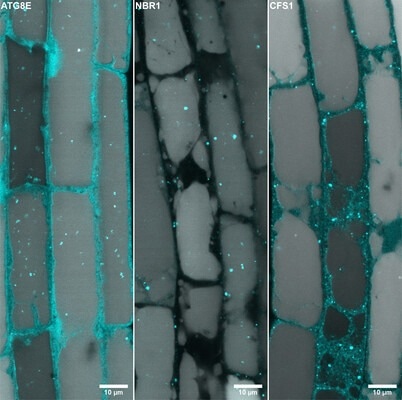A “hub and spoke” system allows plant cells to effectively coordinate cellular trafficking, especially for cellular recycling, also known as autophagy. Autophagosomes are specialized vesicles that capture hazardous molecules and transport them to the vacuole, where they are destroyed.
 The plant autophagy adaptor CFS1 localizes at the outer autophagosome membrane. Confocal microscopy images of Arabidopsis root epidermal cells expressing the autophagosome marker ATG8E (left), the autophagy receptor marker NBR1 (middle), or the newly identified autophagy adaptor CFS1 (right). The vacuoles are shown in gray. NBR1 localizes inside of the autophagosome, whereas ATG8 can localize at both the inner and outer membranes of the autophagosome. The right panel shows that CFS1 is an autophagy adaptor that mainly localizes at the outer autophagosome membrane. Image Credit: ©Dagdas/JCB/GMI.
The plant autophagy adaptor CFS1 localizes at the outer autophagosome membrane. Confocal microscopy images of Arabidopsis root epidermal cells expressing the autophagosome marker ATG8E (left), the autophagy receptor marker NBR1 (middle), or the newly identified autophagy adaptor CFS1 (right). The vacuoles are shown in gray. NBR1 localizes inside of the autophagosome, whereas ATG8 can localize at both the inner and outer membranes of the autophagosome. The right panel shows that CFS1 is an autophagy adaptor that mainly localizes at the outer autophagosome membrane. Image Credit: ©Dagdas/JCB/GMI.
During this trip, autophagosomes mature through molecular pathways that are unknown in plants. Scientists from the Austrian Academy of Sciences’ Gregor Mendel Institute of Molecular Plant Biology (GMI) have now characterized the mechanism through which autophagy exploits the hub and spoke model in plant cells. The results have been published in the Journal of Cell Biology.
Autophagy was initially assumed to be a process by which cells survive when they are starved or stressed. Autophagy, on the other hand, is increasingly viewed as a quality control process that ensures normal cell function by recycling cellular components that have become undesired or dangerous.
The cell replenishes its molecular resources and creates some of the energy required to adapt to environmental changes with the help of autophagy.
Autophagy is carried out by autophagosomes, which are double-membraned vesicles that swallow the material to be digested.
Autophagosomes are organelles that are born, mature, and die. We knew quite a bit about how autophagosomes are born, but much less about their maturation path and delivery to their final destination, especially for plant cells.”
Yasin Dagdas, Study Corresponding Author and Group Leader, Gregor Mendel Institute of Molecular Plant Biology
The vacuole, a huge organelle that comprises nearly 80% of the cell’s volume and is packed with digestive enzymes, is the “final destination” in plant cells.
Numerous vesicular organelles, such as autophagosomes, are active in the cell; they migrate across the cell in a well-organized manner to mature and accomplish their roles. Dagdas and his colleagues demonstrate in their most recent work that plant autophagosomes do not take a direct, linear route to the vacuole.
Dagdas adds, “We don’t know yet if this is true for all plant autophagosomes, but we show that at least some of them stop at a different location before reaching the vacuole.”
The researchers reveal that plant autophagosomes first fuse with other endosomal organelles termed “multivesicular bodies” (MVBs) to generate “amphisomes” using complementary methodologies in biochemistry, cellular imaging, and structural biology. The amphisomes then merge with the vacuole.
The identification of the autophagy adaptor CFS1, a protein that detects membrane marks on both autophagosomes and MVBs and so enables their fusion, is fundamental to their findings. The researchers show that amphisomes act as cellular sorting hubs for autophagosome development and trafficking to the vacuole.
The trafficking pathways are quite complex, but they all need to be coordinated. Generating vesicles is energetically costly for the cell. Hence, we believe that by using the amphisomes as sorting hubs for autophagosomes, the cell optimizes its energetic efficiency.”
Yasin Dagdas, Study Corresponding Author and Group Leader, Gregor Mendel Institute of Molecular Plant Biology
The researchers link this sorting hub model to the “hub and spoke” system used in aviation and other supply chain logistics.
By having all materials transit through centralized hubs, the cell reduces its logistical costs as fewer routes are necessary. In addition, this system allows the cell to be economical, as complicated operations can be performed in the hubs rather than organized separately in each autophagosome.”
Yasin Dagdas, Study Corresponding Author and Group Leader, Gregor Mendel Institute of Molecular Plant Biology
The function of the autophagy adaptor CFS1 was validated in two evolutionarily distinct plant model organisms, Arabidopsis thaliana and Marchantia polymorpha, implying that this method of autophagosome maturation is maintained across plants. Because autophagy is important in the regulation of cell stress, the findings could be useful in engineering plant vesicular trafficking to boost plant stress tolerance.
Source:
Journal reference:
Zhao, J., et al. (2022) Plant autophagosomes mature into amphisomes prior to their delivery to the central vacuole. Journal of Cell Biology. doi.org/10.1083/jcb.202203139.